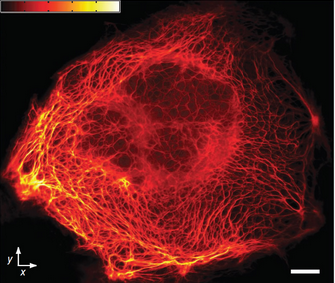Members Login

Channels
Special Offers & Promotions
Fast Andor Neo sCMOS Camera Enables Super-Resolution of Large Fields
A novel super-resolution fluorescence microscope equipped with a low-noise, high-speed 5.5 Megapixel Andor Neo sCMOS camera has enabled the real-time nanoscopic imaging of large fields of living cells for the first time.
 Researchers from the Max Planck Institute in Goettingen, Germany, adopted massive parallelisation techniques to create 116,000 simultaneous scanning points and super-resolve 120 µm × 100 µm fields in less than a second.
Researchers from the Max Planck Institute in Goettingen, Germany, adopted massive parallelisation techniques to create 116,000 simultaneous scanning points and super-resolve 120 µm × 100 µm fields in less than a second.
The research was led by Professor Stefan Hell, who first advanced STED (Stimulated Emission Depletion) and RESOLFT (Reversible Saturable/Switchable Optical Fluorescence Transitions) far-field, super-resolution microscopy. Although RESOLFT can capture images at video rates, until now imaging speed has been governed by the kinetics of fluorophore state transition and, more importantly, the number of scanning steps required to cover the field of view.
Reporting their results in Nature Methods, the team reconciled the major goals of nanoscopy development: low-intensity operation, large fields of view, and fast recording, at a resolution not limited by diffraction. They demonstrated that RESOLFT nonlinear structured illumination can be parallelised using two incoherently superimposed orthogonal standing light waves. The intensity minima of the resulting pattern act as imaging 'doughnuts', providing isotropic resolution in the focal plane and making pattern rotation redundant.
"Super-resolution far-field fluorescence microscopy, which relies on fluorophores transiently assuming different 'on' and 'off' states, is theoretically capable of resolution without any optical limit," says Orla Hanrahan, product specialist at Andor. "Professor Hell has now demonstrated the power of parallelised RESOLFT with a 2D array of 116,000 intensity zero 'doughnuts'. The result is super-fast, super-resolution of living cells with the recording speed lim¬ited only by the state transition kinetics of the fluorophore and the camera frame rate.
"Despite the enormous advancements brought about by electron and scanning probe microscopy, light microscopy uniquely provides non-invasive, 3D imaging of the interior of cells and allows the detection of specific cellular constituents. The advancement in nanosopy demonstrated by Professor Hell and his associates brings much nearer the time when working scientists can easily count molecules in cells in a very simple way and has the potential to revolutionise molecular and cell biology and transform medical and pharmaceutical research."
The Andor Neo 5.5 megapixel sCMOS camera is a unique -40°C vacuum cooled platform designed around a superb, low noise 5.5 megapixel sensor with 6.5 µm pixels and a 22mm diameter to drive lowest possible dark noise. Ideal for cell microscopy, astronomy, digital pathology, and high content screening, the Neo 5.5 delivers an unmatched 30 fps sustained or up to 100 fps burst mode to its internal 4GB memory. The Rolling and Global shutter flexibility further enhances application flexibility, Global shutter in particular offering an ideal means to simply and efficiently synchronize the Neo with other 'moving' devices such as stages or light switching sources and eliminating the possibility of spatial distortion when imaging fast moving objects.
more news from andor technology
Media Partners


